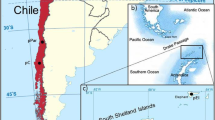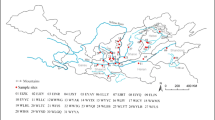Abstract
Caragana korshinskyi Kom. is a long-lived shrub species indigenous to northwestern China, and important in vegetation rehabilitation of widely degraded and degrading semiarid and arid regions because of its high ecological and economic values. Information at molecular level on its genetic diversity, however, is not available. Accordingly, the extent and distribution for genetic diversity and population structure in 11 populations of C. korshinskyi were assessed using polyacrylamide gel electrophoresis for seven enzymes including aminopeptidase, aspartate aminotransferase, glucose-6-phosphate dehydrogenase, malate dehydrogenase, phosphoglucoisomerase, phosphogluconate dehydrogenase, and peroxidase. The seven-enzyme systems produced 11 loci encompassing 19 alleles demonstrating high genetic variation at both species and population levels. A considerable excess of heterozygotes relative to Hardy–Weinberg expectations was detected at the both levels as well. GST ranged from 0.0074 for AMP-1 to 0.4646 for PGD with a mean of 0.1517, indicating that approximately 84.8% of the total allozyme variation occurred within populations. An indirect estimate of the number of migrants per generation indicated that gene flow was high among populations of the species.
Similar content being viewed by others
References
Brown A.H.D. (1979). Enzyme polymorphism in plant populations. Theor. Popul. Biol. 15: 1–42
Bretting P.K. and Widrlechner M.P. (1995). Genetic markers and horticultural germplasm management. Hort. Sci. 29: 1337–4339
Cao W.H. and Zhang X.Y. (1991). Acta Bot. Sin. 33: 181–187
Chang C.Y. and Zhang M.L. (1997). Anatomical structures of young stems and leaves of some Caragana species with their ecological adaptabilities. Bull. Bot. Res. 17: 65–71
Fu H.C. 1989. Caragana. In: Fu H.C.(eds) Flora Intramongolica, 2nd.: Inner Mongolia, People Press, Huhhot, pp. 236–238.
Gottieb L.D. (1981). Electrophorestic evidence and plant populations. In: Reinhold, L., Harborne, T.B. and Swain, T. (eds) Phytochemistry, pp 1–46. Oxford University Press Inc., Pergamon
Hamrick J.L. and Godt M.J.W. (1989). Allozyme diversity in plant species. In: Brown, A.D.H., Clegg, M.T., Kahler, A.L. and Weir, B.S. (eds) Plant Population Genetics, Breeding and Genetic Resources, pp 304–319. Sinauer Press, Sunderland, MA
Hamrick J.L., Godt M.J.W. and Sherman-Broyles S.L. (1992). Factors influencing levels of genetic diversity in woody plant species. New. For. 6: 95–124
Hamrick J.L. and Godt M.J.W. (1997). Allozyme diversity in cultivated crops. Crop Sci. 37: 26–30
Hanelt P. and Institute of Plant Genetics and Crop Plant Research. 2001. Mansfelds Encyclopedia of Agricultural and Horticultural Crops. Springer-Verlag, Berlin etc.
Huh M.K. (1999). Genetic diversity and population structure of Korean alder (Alnus japonica: Betulaceae). Can. J. For. Res. 29: 1311–1316
Ledig F.T. (1986). Hetrizygosity, heterosis and fitness in outbreeding plants. In: Soule, M.E. (eds) Conservation Biology, pp 77–104. Sinauer Press, Sunderland, MA
Li C.C. and Horvitz D.G. (1953). Some methods of estimating the inbreeding coefficient. Am. J. Hum. Genet. 5: 107–117
Li S.B., Wang B., Bai Y.Q. and Wang L. (2000). Studies on the characteristics of the main forage shrub species in Yanchi sandy land. Sci. Sil. Sin. 36: 119–125
Loveless M.D. and Hamrick J.L. (1984). Ecological determinants of genetic structure in plant populations. Ann. Rev. Ecol. Syst. 15: 65–95
Ma C.C., Gao Y.B. and Guo H.Y. (2003a). Interspecific transition among Caragana microphylla C. davazamcii C. korshinskyi along geographic gradient. Characteristics of photosynthesis and water metabolism Acta Bot. Sin. 45: 1228–1237
Ma C.C., Gao Y.B. and Liu H.F. (2003b). Interspecific transition among Caragana microphylla C. davazamcii C. korshinskyi along geographic gradient. Ecological and RAPD evidence Acta Bot. Sin. 45: 1218–1227
Ma C.C., Gao Y.B. and Wang J.L. (2004a). Ecological adaptation of Caragana opulens on the Inner Mongolia plateau: photosynthesis and water metabolism. Acta Phytoecol. Sin. 28: 305–311
Ma C.C., Gao Y.B. and Wang J.L. (2004b). Acta Ecol. Sin. 24: 1594–1601
Markert C.L. (1975). Isozymes IV: Genetics and Evolution. Academic Press, New York, USA
Moore R.J. (1962). J. Arnold Arboretum 43: 203–214
Nei M. (1972). Genetic distance between populations. Am. Nat. 106: 282–292
Nei M. (1973). Analysis of gene diversity in subdivided populations. Proc. Natl. Acad. Sci. USA 70: 3321–3323
Nei M. (1978). Estimation of average heterozygosity and genetic distance from a small number of individuals. Genetics 89: 583–590
Qiu J. and Sun J.T. (2003). A study on pollen morphology of Caragana Fabr. and its taxonomic significance. J. Shangdong. Norm. Univ. 18: 85–87
Rohlf F.J. 1993. Numerical Taxonomy and Multivariate Analysis System.Version 1.8. Exter SoftwareSetauket, New York.
Smouse P.E., Long J.C. and Sokal R.R. (1986). Multiple regression and correlation extensions of the Mantel test of matrix correspondence. Syst. Zool. 35: 627–632
Soltis D.E., Haufler C.H. and Darrow D.C. (1983). Starch gel electrophoresis of fern: a compilation of grinding buffers, gel and electrode buffers, and staining schedules. Am. Fern J. 73: 9–27
Wang X.M. and Gao Z.Y. (2003). Study on process technology and its key technique of wood based panels from desert shrubs. Chin Wood Industry 17: 11–13
Wang H.X., Hu Z.A. and Zhong M. (1994a). Morphological variation of Caragana populations in the Maowusu sandy grassland. Acta Ecol. Sin. 14: 366–371
Wang H.X., Hu Z.A. and Zhong M. (1994b). Seed protein variation of Caragana populations in the Maowusu sandy grassland. Acta Ecol. Sin. 14: 372–380
Wang H.X., Hu Z.A., Zhong M. and Wei W. (1997). Ecological genetics of Caragana ssp.. In: Hu, Z.A. and Zhang, Y.P. (eds) Genetics Diversity of Animals and Plants in China, pp 160–163. Zhejiang Science and Technology Press, Hangzhou
Wendel J.F. and Weeden N.F. (1989). Visualization and interpretation of plant isozyme. In: Soltis, D.E. and Soltis, P.S. (eds) Isozyme in Plant Biology, pp 42–72. Dioscorides Press, PortlandOR
Wei W. 1997. Studies on molecular ecology of populations of leguminous, Caragana spp. and Glycine soja. Ph.D. Thesis, Institute of Botany, Chinese Academy of ScienceBeijing, China.
Wei W., Wang H.X. and Hu Z.A. (1999). Primary studies on molecular ecology of Caragana spp. populations distributed over Maowusu sandy grassland: from RAPD data. Acta Ecol. Sin. 19: 16–22
Wright S. (1965). The interpretation of population structure by F-statistics with species regard to systems of mating. Evolution 19: 395–420
Xiao C.W. and Zhou G.S. (2001). Effect of simulated precipitation change on growthgas exchange and chlorophyll fluorescence of Caragana intermedia in Maowusu sandland. Chin. J. Appl. Ecol. 12: 692–696
Yan L., Li H. and Liu Y. (2002). J. Arid. Land Res. Environ. 16: 100–106
Yang T.X. and Wu Y.W. (1999). Application of electrophoresis in agricultural science. In: He, Z.X. and Wu, Y.W. (eds) Electrophoresis, pp 258–312. Science Press, Beijing
Yeh F.C., Yang R.C. and Boyle T. 1999. POPGENE VERSION 1.32. Microsoft Windows-based Freeware for Population Genetic Analysis. Quick User Guide. Center for International Forestry ResearchUniversity of Alberta.
Zhang X.S. (1994). Principles and optimal models for development of Maowusu sandy grassland. Acta Phytoecol. Sin. 18: 1–16
Zhou Y.G. 1997. Genetic analysis of seed protein, isozyme and population genetic structure in NingTiao (Caragana spp.). M.S. Thesis, Institute of Botany, Chinese Academy of ScienceBeijing, China.
Zhou Y.G., Wang H.X. and Hu Z.A. (2000). Seed protein polymorphism within individual plants and mating system. Acta Bot. Sin. 42: 910–912
Zhou Y., Wang H.X. and Hu Z.A. (2001). Variation of breeding systems in populations of Caragana intermedia in Maowusu sandy grassland. Acta Bot. Sin. 43: 1307–1309
Author information
Authors and Affiliations
Corresponding author
Rights and permissions
About this article
Cite this article
Wang, Z., Gao, H., Han, J. et al. Allozyme Diversity and Population Structure of Caragana korshinskyi Kom.in China. Genet Resour Crop Evol 53, 1689–1697 (2006). https://doi.org/10.1007/s10722-005-1214-z
Received:
Accepted:
Published:
Issue Date:
DOI: https://doi.org/10.1007/s10722-005-1214-z




